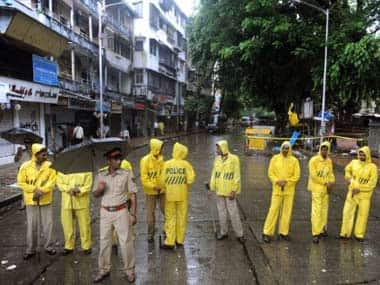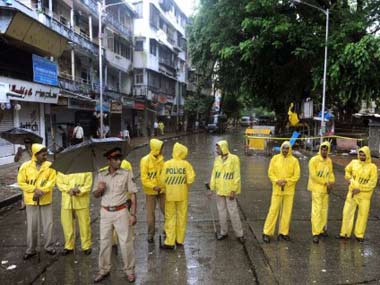Within 30 minutes of Wednesday’s serial blasts in Mumbai, the prime suspect had been identified. It was the Indian Mujahideen (IM). The signature of the secretive outfit in all three explosions was clear, claimed unnamed top police officials. There were telltale signs, they asserted: the incident took place on the 13th, Improvised Explosive Devices (IEDs) were used to trigger the blasts, and the prime targets were localities dominated by the Gujaratis. The pattern followed the blasts at Lucknow and Varanasi in 2007 and at Jaipur and Ahmedabad in 2008, they said. “IM blasts earlier involved IEDs fitted with timers. The bombs were detonated from distant locations. Moreover, projectiles have been found at the spots, a clear indication that the outfit was involved,’’ an anonymous police officer told The Indian Express. [caption id=“attachment_41458” align=“alignleft” width=“380” caption=“We have barked up the wrong tree so many times earlier and made ourselves look stupid by jumping to quick conclusions. AFP Photo”]
 [/caption] Soon the media will be inundated with stories of IM sleeper cell, the Lashkar-e-Taiba connection and the web of terror activity spread across countries. By now, after so many brushes with terror in recent years, we are fairly sure how the narrative will develop. Nothing apparently wrong in the whole exercise though. The investigation process is all about connecting the dots to detect contours of the big picture, and zero in on the culprits. Only, we have barked up the wrong tree so many times earlier and made ourselves look stupid by jumping to quick conclusions. Thirty minutes? Isn’t that too short a time span to catch the criminals? What’s the tearing hurry, guys? In the case of Malegaon blasts, the Anti-Terrorism Squad of the Maharashtra police claimed the involvement of IM and arrested and charge-sheeted the suspects. Five years on, it is becoming clear that the perpetrators were members of a radical Hindu group. The NIA has filed a separate charge sheet against them. The claims of the police have turned upside down in the Samjhauta blast case too, as in the Mecca Masjid and other blasts of 2008. It’s a bit embarrassing. The recent developments render silly the entire media coverage of the investigation into those incidents. Of course, the unnamed police officer was always behind the stories. He, obviously, was taking journalists for a ride. Concocted stories could be the police’s deliberate move to buy peace. There’s simply too much pressure on them. With the media turning increasingly impatient and aggressive about results, it has to be pacified and kept at bay. It has to be fed stories, which may or may not have basis in reality, on a regular basis. The police have to worry about the negative public opinion the media is capable of whipping up too. What we ultimately have is a whole lot of misinformation. It does not help anybody. It does not do a lot of good to the reputation of the police or the credibility of the media. Why can’t we let the investigation proceed at its own pace? Home minister P Chidambaram was right in asking the police to stop speculating on the perpetrators behind Wednesday’s attacks. He was also correct in refusing to answer question on possible Pakistani involvement in the blasts. Unnecessary speculation takes the attention away from investigation and feeds the culture of misinformation. The media must allow the police their space to operate. Otherwise, it would end up looking foolish itself.
[/caption] Soon the media will be inundated with stories of IM sleeper cell, the Lashkar-e-Taiba connection and the web of terror activity spread across countries. By now, after so many brushes with terror in recent years, we are fairly sure how the narrative will develop. Nothing apparently wrong in the whole exercise though. The investigation process is all about connecting the dots to detect contours of the big picture, and zero in on the culprits. Only, we have barked up the wrong tree so many times earlier and made ourselves look stupid by jumping to quick conclusions. Thirty minutes? Isn’t that too short a time span to catch the criminals? What’s the tearing hurry, guys? In the case of Malegaon blasts, the Anti-Terrorism Squad of the Maharashtra police claimed the involvement of IM and arrested and charge-sheeted the suspects. Five years on, it is becoming clear that the perpetrators were members of a radical Hindu group. The NIA has filed a separate charge sheet against them. The claims of the police have turned upside down in the Samjhauta blast case too, as in the Mecca Masjid and other blasts of 2008. It’s a bit embarrassing. The recent developments render silly the entire media coverage of the investigation into those incidents. Of course, the unnamed police officer was always behind the stories. He, obviously, was taking journalists for a ride. Concocted stories could be the police’s deliberate move to buy peace. There’s simply too much pressure on them. With the media turning increasingly impatient and aggressive about results, it has to be pacified and kept at bay. It has to be fed stories, which may or may not have basis in reality, on a regular basis. The police have to worry about the negative public opinion the media is capable of whipping up too. What we ultimately have is a whole lot of misinformation. It does not help anybody. It does not do a lot of good to the reputation of the police or the credibility of the media. Why can’t we let the investigation proceed at its own pace? Home minister P Chidambaram was right in asking the police to stop speculating on the perpetrators behind Wednesday’s attacks. He was also correct in refusing to answer question on possible Pakistani involvement in the blasts. Unnecessary speculation takes the attention away from investigation and feeds the culture of misinformation. The media must allow the police their space to operate. Otherwise, it would end up looking foolish itself.
Cops on steroids: How were culprits detected in 30 minutes?
Akshaya Mishra
• July 14, 2011, 16:50:17 IST
Once again, the police has given in to media pressure by fixing blame a little to soon. What we’ll ultimately have is a whole lot of misinformation, as developments in recent terror cases have shown.
Advertisement
)
End of Article